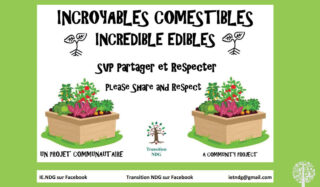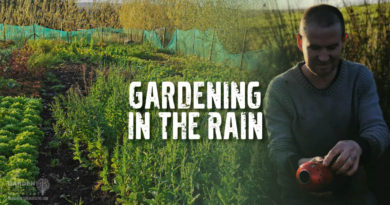Urban Gardening with Incredible Edibles
For city dwellers, the gentle gift of harvest is most often seen in farmers’ markets at best. Or, more likely, bound within an inch of its life in plastic at the local superstore. Raising crops in the city is difficult due to a lack of space and light. Ever-increasing awareness of food miles, the knowledge that grocery stores only stock three days of food, and the desire to eat local have brought more urbanites to grips with growing food on balconies and whatever can be grown in little shady city gardens. Interest sharpens slightly, living just north of the 45th parallel where the winter is long and the growing season is not.
Urban Growing
My urban growing adventure began in Montreal, Quebec, around 2011. As so many modern tales start, I’d received a three-minute video from a friend, filmed in a market town in Todmorden, Yorkshire, UK. This town’s people had taken its unused green spaces and had begun growing vegetables for all to share. All of the plants were donated, planted, and cared for by volunteers and were to be shared by the community.
No one had to make an application to collect from any of these gardens. It was entirely free for the community to harvest at will. And no one had abused it.


Perhaps it was seeing Mary Clear in the video saying, “Old people like a bit of mint with their new potatoes” as she stood in one of the car parks home to several herb plantings. Or maybe it was Pam Warhurst with her trademark tongue-in-cheek narration, sliding in comments like “food in your face propaganda gardening”. Or the older handyman perched on the edge of a street planter, saying he just “needed to do something meaningful”.
Community Connection
The townspeople had come together around the need to feed themselves, but more than that, they needed to be involved with each other and share. The local high school got a greenhouse. Then, the Prince of Wales visited with a royal seal of approval. Support begat support. They lined the canal that passed through the town with planters and built a meadow near the new doctor’s surgery named Pollination Street. The whole town had become a wonderland of food planting. All the work was volunteer, and all the food was for sharing between them and harvesting at will. By the time I’d heard their message, there was an international network of Incredible Edible towns throughout much of the English-speaking world, France and beyond.
They conspired in the message of their endeavour to remind me of the importance of food, community and sharing. Everything didn’t have to be bought and paid for—a modern gift culture. The idea of growing and sharing food as a community cuts through the current practice most of us endure of grocery shopping in the superstore garden to lay bare the communal aspects of our nourishment.


Incredible Edibles In Montreal, QC
It appealed greatly to my itchy green fingers. To my great surprise, in 2012, the Westmount Horticultural Society, which I had recently joined, agreed to take the idea to the City of Westmount. I showed them the video and waxed on about the benefit that local food growing has on a community. Again, to my surprise, the city agreed immediately to support the idea. However, instead of the volunteer troupe of gardeners and residents I had envisioned, the city would manage the entire project, including the planting, maintenance, and watering. I helped select the plants which they bought. The city planners worried that the residents wouldn’t like it if it began to look “too weedy”. They suggested planting up and down three blocks of the big main street and a large planting at the end of Prince Albert Avenue, where I lived.
Me? I was already walking the talk. I had transformed our little city garden into a demonstration microfood forest with six fruit trees, loads of berries and some crops on the roof sandwiched between two two-story townhouses. It also held five laying hens with a beehive on an upstairs deck.
The city enlisted a young woman named Jayme Gerbrant, newly from Winnipeg. In the first year, we planted herbs, cherry tomatoes, chard, two kinds of kale, and nasturtiums. It wasn’t crops, but it was edible, and anyone could harvest it. We posted suggested cropping techniques for the herbs and the greens. At the end of the season, some friends and I harvested what remained and brought it to the local food bank in the next borough over.
The following year, I recruited the local high school to help with the final harvest, again bringing it to the food bank. Soon after the second harvest, it became clear that my husband’s parents required help in the UK. Off we went, leaving the project in the very able hands of the city.
Jayme has been able to keep the project going since then. She added a fruit tree program for residents, including apples, pears, and sweet chestnut trees. The herb and vegetable plantings have since moved to the main parks and city hall. They’ve planted a pear orchard in the park and built a potager on the underground hockey arena. They have established a “seed lending” program at the library where residents return seeds from the next generation of plants. The end-of-the-season harvests are well supported by the community.


Widespread Interest
While I was packing my bags for the UK, the next borough over, the one with the food bank, was tooling up their version of Incredible Edibles (IE) under the umbrella of Transition NDG. The borough of Notre-Dame-de-Grace’s (NDG) version of IE was entirely volunteer, built on community participation, and truer to the original design. Churchyards were transformed into potagers, and local businesses adopted storefront planters. Front lawns turned into edible gardens. The local grocery store sponsored a planting of herbs and veg at the fire station. A large planting space was donated by a resident for shared planting of freely available produce. A couple of primary schools have begun starting seedlings for IE, tending them and watching the magic happen from tiny seed to bushy little plant. A play was written. Over ten years, NDG has built eight IE gardens, and countless citizens have converted their small front and back gardens to grow produce. All activities are organised and presented in both English and French!
Recently, NDG invited me to talk at the 10th anniversary picnic. It was a small turnout on a chilly evening, just the hardcore. And we reminisced. After the gathering, I thought it would be nice to see if it’s possible to kick some Incredible Edibles into gear in the Quebec Laurentians where I now live. It doesn’t take much, really. It is surprising how ready we all are for food that is not business as usual. It just takes a few willing hands to plant seeds and a desire to share the harvest.
Marci’s recommendations for further reading:
Incredible Edibles Todmorden: incredible-edible-todmorden.co.uk
TED.com: rebrand.ly/e47f73
Incredible Edibles Westmount: westmount.org/en/environment/incredible-edibles
Incredible Edibles NDG: IE.NDG




